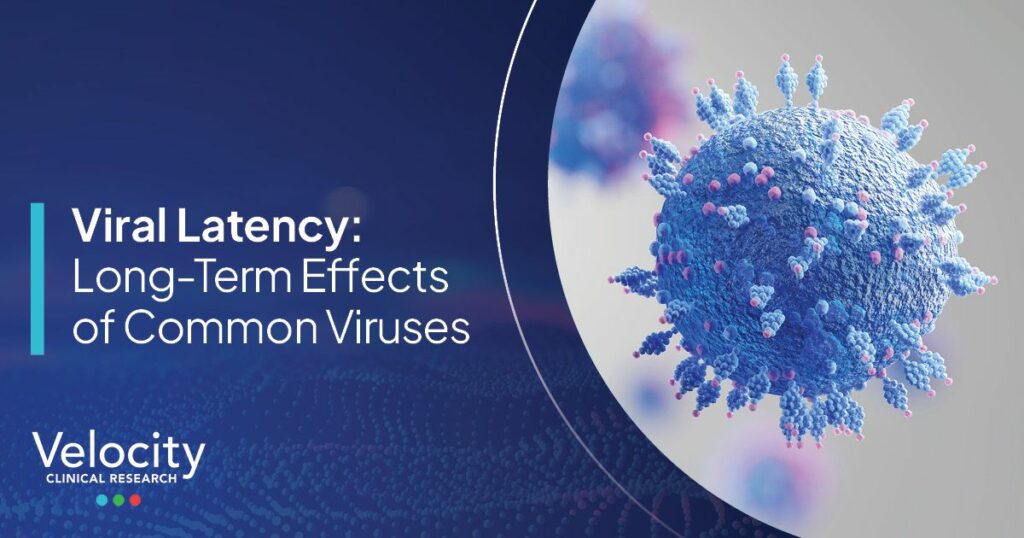You may have seen the term “Long COVID” in headlines over the past year or two. While lingering or delayed effects from a viral infection may seem like a new discovery, evidence suggests that some viruses can lay dormant in a body for years before triggering other symptoms later.
What is Viral Latency?
When the full genome of a virus remains in the host cell, but is restricted and unable to produce infectious particles, the virus is considered dormant in the body. However, for the virus to be considered latent, two additional conditions must be met: persistence and reversibility. Persistence is the viral genome’s ability to survive the body’s immune responses and remain in the host cell. Reversibility refers to the capacity of the viral genome to reactivate its infectious properties.
Which Viruses Can be Latent or Cause Latent Infections?
Most viruses cannot meet the full requirements of latency, but a few viruses have shown their ability lay dormant for a length of time before reactivating in the host cell. The family of herpesviruses – including cytomegalovirus (CMV) and Epstein-Barr virus (EBV) – as well as influenza, chickenpox, and coronaviruses are a few that can remain latent.
Long-Term Effects of Coronavirus (COVID-19)
“Long COVID” describes when a person who contracted COVID-19 continues to experience symptoms of the illness long after the viral infection should have run its course. People with post-COVID conditions can experience a wide range of symptoms for weeks, months, and even longer after the initial infection. These symptoms can include general fatigue, especially after exercise, as well as respiratory, heart, digestive, and neurological issues.
Since COVID-19 is a relatively new disease, we don’t yet understand the latency properties of the SARS-Cov-2 virus. Early findings, some not yet peer-reviewed, indicate that in many people experiencing long covid, viral RNA is still strongly present in tissue samples months or even years after the initial infection. However, this may not be the cause of long COVID – other factors may be at play. While more research is needed to clarify the cause of post-COVID conditions, there is some hope that clearing the remaining viral RNA in the body might cure long COVID.
The Relationship Between Chickenpox and Shingles
Chickenpox is a highly contagious illness caused by the varicella-zoster virus (VZV). Characterized by a rash of itchy, fluid-filled blisters that typically appear on the face, chest, and back, chickenpox is most common in children, but can also affect adults who have not been vaccinated or been infected.
After a person has had chickenpox, the virus remains dormant in the body. In some people, the virus can reactivate later in life and cause a condition called shingles. Shingles, also known as herpes zoster, is a painful rash that typically appears on one side of the face or body. Shingles is more common in people age 50 and older and in those with weakened immune systems. It can be treated with antiviral medications, but it can be a severe and painful condition. In addition to shingles, chickenpox can also cause a condition called post-herpetic neuralgia, which is a type of nerve pain that can persist for months or years after the initial chickenpox infection has resolved. This pain is usually limited to the area of the body where the shingles rash occurred.
Cytomegalovirus (CMV) Latency
Infecting more than half of adults by the age of 40, Cytomegalovirus (CMV) is a highly infectious herpesvirus. While most people who become infected with CMV exhibit no symptoms, the virus can cause major birth defects in infants whose mothers become sick while pregnant. This is known as congenital CMV. Mononucleosis, known better as mono, can also be triggered by a CMV infection.
CMV evolved to be a latent virus, and can lay dormant in the body for the entirety of the host’s life after initial infection. CMV reactivations are typically triggered through inflammation in certain cells of the body. CMV typically only reactivates in critically ill and/or immunosuppressed persons. Well-documented in heart transplant patients and evidenced in the general population, CMV is a leading cause of atherosclerosis, or the hardening of the arteries, which can lead to heart disease and mortality.
Long-Term Effects of Epstein Barr Virus (EBV)
Epstein Barr Virus (EBV), also a member of the herpesvirus family, is the most common cause of infectious mononucleosis (IM), generally known as mono. Sometimes referred to as the kissing disease, mononucleosis spreads easily through saliva and occurs primarily in adolescents and young adults. Most people will be infected with EBV in their lifetime.
After the initial infection, EBV lays dormant in the body. If it reactivates, it seldom causes symptoms. However, in some people, especially those with weakened immune systems, EBV can cause chronic or serial infections with symptoms similar to the original infection. It is believed that, similarly to CMV, EBV is reactivated due to inflammation in the body.
EBV’s latency can cause other, more critical health issues. It may be linked to certain cancers, including Hodgkin’s, non-Hodgkin’s, and Burkitt’s lymphoma, and may increase the risk of nasopharyngeal carcinoma. EBV’s role in the development of these cancers is still unclear. It is estimated that about 200,000 new cancer diagnoses are a result of EBV infection each year. Recently, early research has shown that EBV may also trigger the development of multiple sclerosis (MS). More research is needed, but initial findings suggest that EBV may be much more dangerous than initially thought.
Long-Term Effects of Influenza
There is some evidence to suggest that influenza, also known as the flu, may be linked to the development of neurological disorders, such as encephalitis lethargica (EL), a disorder caused by inflammation of the brain and spinal cord, as well as Parkinson’s disease (PD), a progressive neurological disorder that affects movement and can cause tremors, stiffness, and difficulty with balance and coordination.
Several studies have found a possible association between influenza infection and an increased risk of Parkinson’s disease, although the exact mechanisms behind this link are not fully understood. It is possible that the inflammation caused by influenza may play a role in the development of these neurological disorders, although more research is needed to confirm this theory. It is also important to note that most people who have influenza do not develop neurological issues, and influenza is not a direct cause of PD or EL.
How to Prevent These Viruses
There are several measures that can help prevent viral infections: washing your hands frequently with soap and water, avoiding close contact with people who are sick, wearing as mask in public, and disinfecting frequently touched surfaces. Vaccines are also available for several viral infections, including chickenpox, influenza, and COVID-19.
As for CMV and EBV, there are several investigational vaccines being evaluated in clinical trials. Velocity is currently enrolling adults for numerous vaccine studies, including CMV and EBV, as well as influenza, chickenpox, and COVID-19 studies. Participants in these studies may receive investigational vaccines and, in some cases, an FDA-approved vaccine at no cost. Eligible participants may also receive compensation for study-related time.
To learn more about current and upcoming clinical trials at Velocity, visit our find a clinical trial page.
References and Further Reading
CMV
EBV
- https://www.healthline.com/health/epstein-barr-virus
- https://www.scientificamerican.com/article/epstein-barr-virus-found-to-trigger-multiple-sclerosis/
COVID
- https://www.nationalgeographic.com/science/article/persisting-coronavirus-could-drag-out-covid-19-symptoms
- https://www.cdc.gov/coronavirus/2019-ncov/long-term-effects/index.html
Chickenpox
Influenza

